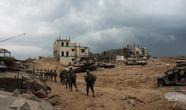
Israel faces spike in rocket fire, despite northern Gaza progress
Israel on Monday faced increased rocket fire in both the North and the South, despite slow but steady progress rooting out Hamas in northern Gaza.
Two drones and rockets were launched toward Israel after IDF artillery forces struck several terrorist targets across the Lebanese border early Monday morning.
Hezbollah’s counterattack struck the IDF’s Beiranit Brigade base, causing significant damage to infrastructure and fires but no casualties.
Many civilians in that part of the North were evacuated last month.
In response, the IDF attacked the source of the rocket fire.
Later on Monday, IAF fighter jets struck Hezbollah military infrastructure.
Sirens sounded throughout the North on Monday evening after suspected enemy drone intrusions.
Earlier on Monday, soldiers struck a terrorist cell in the Metulla area. Later on Monday, numerous air-raid sirens were sounded in Tel Aviv and central Israel, although not many rockets were launched in that barrage.
Hamas’s rocket attacks at Tel Aviv and central Israel were the first since Friday. Last week, a senior IDF officer said northern Gaza rocket fire had declined 80%, with the number of air-raid sirens dropping from several hundred per day, to more than 100, to 70, to 50, and then to about 20.
The IDF on Monday said it had shot down two rockets – one by Iron Dome and one by David’s Sling.
The unusually large number of air-raid sirens was not because of the rockets but due to the unpredictable way the shrapnel from the destroyed rockets might land, the IDF said.
The IDF continued its operations across the Gaza Strip on Monday, killing three Hamas division commanders after being led to the terrorists by the Shin Bet (Israel Security Agency) and the Military Intelligence Directorate.
IDF announces names of three soldiers killed in fighting in Gaza
Shrapnel from a rocket struck a vehicle in Holon on Monday night. No casualties were reported.The IDF said it was continuing to make progress in heavy fighting against Hamas in Jabalya and Zeitoun, east of central Gaza City, which it had already mostly cleaned out last week.The IDF had subdued Hamas’s largest forces in the center of Gaza City, but it was facing temporary heavy resistance again because it had skipped fighting Hamas in the eastern neighborhoods until now, IDF Spokesman R.-Adm. Daniel Hagari said Monday.
This meant that even if Hamas terrorists in the center of Gaza City were now extremely weak, the eastern neighborhoods still had not yet been worn down by the IDF, he said.
The IDF would wear them down, he said, implying that this will occur within days.
Hagari also said the IDF would start to reduce the number of reserves actively serving to enable the economy to recover and to keep reservists from getting exhausted. Simultaneously, the IDF would rotate reservists back into service where necessary, but this rotation system would give many reservists longer breaks, he said.
This is supposed to enable the IDF to continue a longer war than it has fought in the past, while finding a balance for the reservists, Hagari said.
It was still unclear when the IDF will send ground troops in large numbers into southern Gaza. Airstrikes have increased there, but any major progress appears to be on pause until the government decides whether it will cut a hostage deal with Hamas in exchange for a temporary pause in the fighting.
Separately, security authorities on Monday said two Hamas terrorists who had infiltrated from Gaza during the October 7 terrorist attack were arrested in Rahat two weeks ago. They were arrested by the undercover unit of the Border Police’s Southern District Unit in coordination with the Shin Bet (Israel Security Agency).
About 3,000 Hamas terrorists infiltrated from Gaza on October 7. Many of them were killed in battle, and more that 100 were captured. On October 17, the IDF said there were still Hamas terrorist cells roaming the Negev and waiting to come out from their hiding spots to attack civilians.
Source » jpost.com





